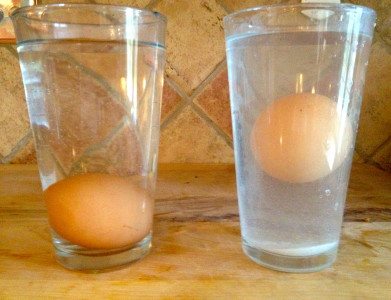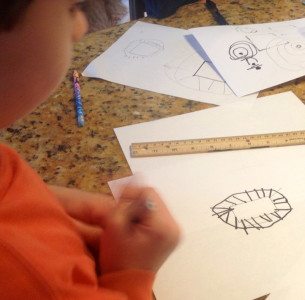
As we all know, kids are natural scientists. They are constantly observing and asking questions about the world around them. It truly is never too early to get kids exploring with hands-on science activities. Here are some fun, easy, and interesting experiments that I recently found online and tried out at home.
Water Splashes
Kids love throwing rocks in water, looking at the splash, listening to the plop as the rock hits, and staring at the ripples. This is a fun experiment that demonstrates that any object, regardless of the shape, will produce a circular pattern of ripples when thrown into water.

The experiment calls for wooden objects of various shape, such as a circle, a square and a triangle. The premise is to throw the different shaped objects in the water, and observe that regardless of the object’s shape, a circular patter of water is displaced. This happens because as the object hits the water, energy is released from the center of the object, equally in every direction. When a square block hits water, an infinite amount of straight lines of energy are released from the center. A circle is the only shape that has an equal distance from the center to any other place on the circle. This is why regardless of shape when a rock or block hits water, the water is displaced in a circular pattern.
To give the kids a visual of this before we went throwing and splashing, we traced blocks of various shapes, made a dot in the center and drew lines going out of the shape in every direction. If you do this step, make sure that the kids make lines bisecting all the angles. While doing this, a circular pattern of lines will appear.
When we tried observing splashes and ripples with our wooden blocks, they just were not heavy enough to produce a good splash. I opened the bathroom cabinet and we starting throwing random items in the tub. A rectangular bar of soap in its cardboard container made a large circular splash, as did a bottle of rubbing alcohol. The kids had the best time repeatedly throwing in a heavy ring box. This box provided a great circular splash and ripples despite it’s cubic shape.
You can ditch the tub and discuss this idea the next time your kids are throwing rocks in water. Simply collect a pile of different shaped rocks, talk about whether they think the splashes and ripples will be similar or different and let them have at it! It’s a great way to get the kids thinking about how the beautiful and amazing things that they observe on a daily basis can be explained by science.
Floating Egg
This is a really easy experiment with fantastic visuals. It will introduce kids to density and mixtures in a very fun way.
Simply fill two glasses with water, grab two eggs, and some salt. Make sure that both glasses have the same amount of water. Leave one glass of water alone and then make salt water in the second glass. After the kids make the salt water mixture, have them carefully add a raw egg to the glass with just water. The egg will sink to the bottom. Then add the egg to the saltwater. The salt water is more dense than the egg, so the egg will now float!

The next day, we took the egg out of the glass with salt water and carefully added a few inches of tap water on top of the salt water. Do this step and then have the kids slowly add the egg back. Watch what happens now! (Hint, see top photo)
Kids are innately curious and will probably ask, “Why does the egg float?” When salt is added to water, the salt dissolves and you now have a mixture. When salt is added to water, it dissolves and sodium and chloride bond with the water’s hydrogen and oxygen. There is now more matter in the same amount of volume, therefore the water is more dense.
With young kids, it’s more about getting them to have fun while making cool observations rather than nailing down the concepts. My kids are young, so I kept the explanation a bit simpler. I told them that once we added the salt to water, we made a mixture. The mixture has more molecules in the same amount of space, and is therefore more crowded, stronger, and dense than water. Not exactly a perfect definition of density, but enough to get young kids understanding what they see.
If your kids want to play more with density, a great way to visualize density is to layer different liquids on top of each other. Take a glass and pour in the same volume of corn syrup, oil, and water. The heavier (more molecules per volume), more dense, liquids will sink to the bottom, and layers will form. If you have food coloring on hand, let the kids color the water first. It creates a fantastic visual.
Have fun! After all, that’s what learning about science should be about!

Howdy! Thiѕ post couldn’t be written any better!
Looking at this aгtiсle reminds me of my previous roommate!
He continually kept preaching about this. I’ll forward
this articlе to him. Pretty sure he’s going to have a good read.
Thank you for sharing!
Nice game for kids. For the better experiments try to visit kidzgeek.com it’s for the baby.